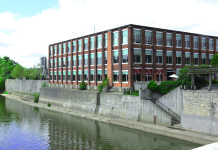University of Waterloo is known for its engineering program and impressive startups, but drone-related technology is starting to come out of UW much more frequently.</p>
The most recent association with drones and UW can be found in the recent Fort McMurray forest fires. The fires were mapped by drones from Aeryon Labs, a UW graduate-founded company currently based in Waterloo. Their drones helped co-ordinate and assess current forest fighting efforts, allowing a birds-eye view in a restricted airspace.
This was not the first time Aeryon had provided air support; in 2015, they aided ground relief teams after a 7.8 magnitude earthquake in Nepal, and in 2014, they helped map hard-hit, high-need areas after a typhoon in the Philippines. In the future, the company plans to focus on military reconnaissance and commercial safety use, such as power line inspection.
Drones can have industry-specific work as well as safety, as seen via Perceptiv Labs, which was started at Velocity in July 2014. In February 2015, Perceptiv Labs launched SHIFT into the film-making industry. SHIFT is a vision-guided drone camera that allows advanced methods of pans, zooms and fly-by shots. Using a phone or tablet, a user can pick a subject to track that the drone will follow, regardless of where the target goes or how the user flies the drone.
Self-driving car technology, another form of autonomous technology, can also be linked back to the University of Waterloo. The Waterloo Autonomous Vehicles Laboratory (WAVELab), was producing autonomous cars in 2013, though at a one-fifth scale. Their focus wasn’t the autonomous driving, but rather how autonomous vehicles would interact with each other.
WAVELab continues to work on self-driving technology, but also has research focused on drones. In 2014, WAVELab was able to co-ordinate autonomous docking between two drones, one in the air and on one the ground. This allows numerous possibilities: for example, a drone with low battery life could coordinate with a land drone that houses a recharge station, thus the former can continue its work longer without returning to base. Another scenario would be a flight drone docking with a land drone that acts as a warehouse, thereby allowing a package drop-off without human interaction.
There is also considerable work being done in drone technology through Velocity startups. In March 2016, Pegasus Aeronautics, a startup that specializes in high endurance aerial platforms, won $35,000 from Velocity Funds. The company won in the $25,000 category, also taking the top prize for hardware, worth $10,000.
Pegasus develops hybrid power batteries that can replace the lithium-polymer batteries typically seen in drones. Their product is lighter and provides equal performance output. Additionally, the Pegasus hybrid battery would last 80 times longer than a normal battery and is marketed as easy to use and service. The start-up hopes wishes to provide a viable power alternative for industrial operators and their drones. From winning the competition, Pegasus will continue to operate out of the Velocity Garage.
Along with the Pegasus, there are three other autonomous robotic tech startups associated with Velocity. Vertical produces an app that syncs with drones to capture video, similar to Perceptiv Labs. The Landmine Boys are developing an automated method to deactivate landmines via a specialized robot. Finally, Avidbots is producing a self-driving floor scrubber capable of adapting to any facility, but which can also be used manually.































